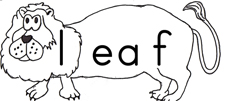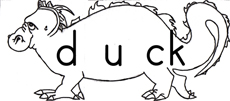![]()
Home | Crosswords | Word Searches | Flash Cards | Verbs | Songs | Creative Writing | Work Sheets | Phonics | ABCs Survival English | Business ESL | ESL for Adults | Articles for Teaching ESL | Lesson Plans | Young Learners ESL | ESL Jobs |
phoneme: a phoneme is the most basic unit of sound.
grapheme: a grapheme is the written representation of a phoneme. A grapheme can consist of one, two, and rarely three or four letters. The phoneme /k/ can be represented by the graphemes C, K, or CK as in cat, kite, and duck.
Phonic Monsters
The phonic monsters are a fun way to learn and practice phoneme-grapheme correspondences. The phonic monsters are a series of 18 plus words that contain all of the phonemes in the English language and most of the basic graphemes that are used to represents these phonemes. Each word is depicted as a monster with a head, a belly, and a tail, which represent the CVC words. An extra set of legs can be added later to make CCVC words or CVCC words. The concept is best explained with illustrations.
The graphics to the right show how the head of the monster 'leaf', which is composed of three graphemes 'l', 'ea', and 'f', can be combined with the belly and tail of the monster 'duck', which is composed of three graphemes 'd', 'u', and 'ck', to form a new monster called 'luck'.
There are a number of activities and some really fun games that can be played with these cards. The cards can be used to both introduce and review the regular phoneme-grapheme correspondences. But it is important to think about which monster parts you want to introduce and when. Having all of the monsters out at once right at the start can make it difficult for students to form words. The downloads are below with some comments. Below the downloads are some links to game suggestions for using these resources.



Basic Monsters
Blank Head and Blank Tail
Extra Heads
Extra Bellies
Extra Tails
Extra Front Legs
T, N, M, and P for S combinations
Games and Activties
Change It!
One great activity to play is the game Phonics Change It! In this phonics game, students make words by removing either a head, body, or tail of a monster.
Basic Consonants and Vowels
These are the basic monsters. They contain most of the basic consonants such as B, C, D, F, G as well the most basic consonant digraphs such as SH, CH, and TH. They do not contain rare digraphs (such as KN, GH, PS and in knight, ghost, or psychology).
They contain the short vowels, A, E, I, O, and U, and common vowel digraphs such as EA, EE, OA, and AI. Missing are complex vowel graphemes such as IGH and OUGH. Long vowels indicated by a Silent E are also not represented (words such as like and make).
We have also included common diphthongs such as AY and OY.
R-Controlled Vowels
We present the R-controlled vowel OR, AR, and IR as single graphemes, which is somewhat contentious as they are not really single phonemes in every English dialect (though they are in some). But they are hard to separate for children and hence, we find it is easier to teach them as single units of sounds presented as digraphs. QU also presents a problem with our one phoneme, one grapheme correspondence because the QU graphical representation represents two distinct phonemes /k/ and /w/. Kids, however, no problem with equating QU and /kw/.
Blank Head and Tail
We have included a blank head and tail for words that start or finish on the vowel phoneme such as EAT, UP, ON, SEA, COW, and GO. (Note: COW ends in the vowel digraph OW not a consonant W).
Consonant-Consonant Blends in Initial Position
We have also included extra front legs to make some CCVC words such as grab or clock. We recommend you leave these out initially to keep the monster building simple. Then, later, you can add the R and L front legs. R and L are by far the most common second consonant phonemes. The way initial consonants can be combined is in fact very limited. Most consonants can be followed by R or L as in brick, block, creep, clock, draw, flaw, frost. /w/ and /y/ could also be combined with most consonants but are in fact only rarely combined like this in English: twin, Sir Gwain, thwart. In other languages (Korean for example), /y/ and /w/ are combined regularly with other consonants. But since we are interested in high yield combinations in English, we recommend teachers or parents stick to the R and L front legs. S is the major exception to this rule. When a word starts with S, there are many possible combinations as in smart, snail, skate, start, and space. When making S words the teacher or parent may want to print of the extra front legs for S words.
Final Consonant/Consonant Blends
Finally, we haven't included final consonant-consonant blends (though we may later) because we feel they would complicate the monster making process greatly. However, we did make an ST tail representing two phonemes since this was such a common and important combination as in FIRST, LAST, WORST, BEST, MOST, FAST, PAST, and LIST. As well, R is included in the R-controlled vowels OR, AR, and IR so these cards have a great deal of flexibility.
Other Phonics Worksheet Sections:
initial sounds | final sounds | select patterns | vowel combinations
Other Spelling Worksheets:
Here is a selection of worksheets available for young learners young ESL learners:
Young Learners | ABC Cards | ABC Mazes | Connect-the-Dots | First Words | Alpha Trains
Little Letters | Big Letters | Opposites | Bingo | Flashcards | Holiday Worksheets
All materials (c) 2007 Lanternfish ESL